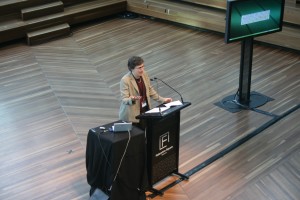By Rachel O’Reilly
Re:live 09, the third international conference on the Histories of Media Art, Science and Technology was held in Melbourne from 26 – 29 of November this year, alongside a cluster of parallel programmed events across the city including the Superhuman Exhibition, Symposium and Curatorial Masterclass run by the Australian Network for Art and technology; a SymbioticA Workshop [Also ANAT]; and the Re: Live Leonardo Education Forum. Select reports from Re:live and the Superhuman Curatorial Masterclass follow.
—
Lisa Gitelman, Associate Professor in the Departments of English and Media Culture and Communication at NYU and author of Always Already New: Media History, and the Data of Culture, opened Re:live with a great media archaeological paper. Beginning with a theorization of the paper-based ‘blank’ within the larger analogue industry of modern jobprinting, she considered “the work that paper does” as a neglected aspect of media and labour theory, and as an antecedent mainframing industrial culture precursory to softwarized information culture.
“Jobprinting” includes bank-books, bankers’ cases, bill-books, blotters, cash-books, check-books, collection-books, exercise and manuscript books, diaries, drawing-books, engineers’ field-books, fern and moss albums etc. It represented 30% of the value of the print culture economy at the turn of the century but has escaped media history. While media studies takes up with the impact and historical linkages of authored texts, jobprinting asks questions about the material role of local desubjectifying acts of knowledge-ordering by “users” of blanks in public sphere formation – not dissimilar to digital “users” working with today’s blanks under the influence of metadata. Deeply wrought into modern print culture (Gitelman gave a wonderful taxonomy of printed blanks prior to a close reading of Edgar Allen Poe’s materialist appreciation of paper in The Purloined Letter), the blank requires instead a sort of inverse method of analysis from affective labour studies:
“One doesn’t identify with the bank to write a check or with the insurance company to file a claim. Chat with a teller and commiserate with your agent—by all means—but that’s precisely what you don’t do on paper, filling in the blanks. The game of “I know you know I know you know” played or gestured toward by the authors, publishers, and readers of nominal blanks cannot happen here, because the bank and the insurance company do not know what you know. They are “they,” endowed with agency in part according to the bureaucratic processes of collecting and managing what you know.”
Gitelman cites historical “limit cases” challenged the bureaucratising/rationalizing force of the blank. The public trial and hanging of a “blank” in Boston – a piece of official embossed paper newly arrived from Britain in February 1766 – following the imposition of a Stamp Tax by Great Britain which sought to officiate the use of paper throughout its colonies. An unsuccessful challenge in the US Supreme Court during the 19th century of the legality of the (first) fine print pre-printed upon Western Union telegram “blanks” (upon which senders wrote messages for transmission) which indemnified the company from liability for “garbled messages” – this being precursory to today’s end user licence agreements. The third example, Baker v. Selden (1872), was a key moment in American copyright law distinguishing between ‘idea/expression’ in the copyright of two rival bookkeeping methodologies and their printed forms, and which defined the blank’s formal and legal identity: blanks don’t carry authorship.
This was great materialist public sphere theory and history attending to commerce and the credit economy, specific bureaucratic authorities, and workplaces, rather than, or in parallel to the “subjectivities of reading” analyses and assumptions of literary cultural theory. Gitelman’s site is here: https://files.nyu.edu/lg91/public/


Credits pictures: Adinda van ‘t Klooster and Re:Live, 2009

